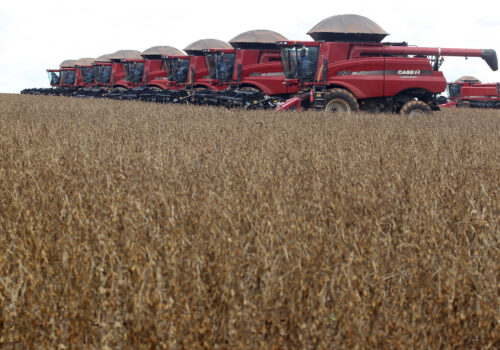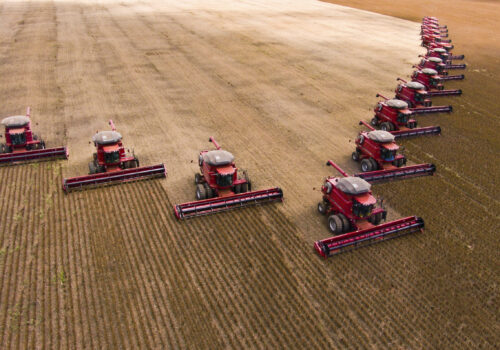How Canada can become a global food security superpower
Achieving food security is a strategic imperative across the Americas. Canada is a critical piece of this hemispheric equation, given its agricultural scale and capacity for innovation. Yet to maximize its potential as a hemispheric and global food security superpower, Canada will need to overcome constraints that hinder its competitiveness and ability to deliver its agricultural assets to global markets. By rectifying these shortcomings and focusing on productivity growth, Canada can build a stronger and more resilient agri-food system that will allow it to play the role of food security superpower well into the future.
In late May, the Scowcroft Center for Strategy and Security’s GeoStrategy Initiative, in partnership with the Mosaic Company, hosted the second private roundtable of its Food Security: Strategic Alignment in the Americas project. This roundtable, held in Ottawa, brought together dozens of leading experts from research institutions, universities, the agri-food industry, government, and multilateral institutions across Canada and the Americas. Our conclusions are based on the insights from this discussion.
Canada’s challenge
Though Canada is a relatively food-secure nation, its agri-food sector nonetheless faces multiple challenges. These challenges inhibit Canada’s farmers and agri-food manufacturers, processors, and retailers from reaching their potential. For example, Canada has transportation and logistics bottlenecks, as well as limited funds for research and development (R&D) in science and innovation. The country is also experiencing declines in its arable cropland and a deterioration of its soil health, which increase the urgency of upgrading its agricultural sector’s climate resilience through a range of investments and improved practices.
Politics and economics are also factors. On July 10, US President Trump threatened a 35 percent tariff on Canadian imports, including agriculture products. While trade negotiations between Ottawa and Washington are ongoing, the prospect of rising trade tensions is a concern. Canadian farmers fear that if trade tensions continue or get worse, then it would likely limit access to affordable, steady supplies of crop inputs, including chemicals, seeds, and fertilizer. This concern has underscored the need to improve national self-sufficiency for the sustainability and resiliency of Canadian agriculture. Such efforts require public sector policies that will help insulate Canada’s agri-food system from external disruptions to markets and related systems, such as crop insurance programs designed to support uncertain production conditions.
Four ways forward
There are four main reasons why Canada has not yet reached its potential as a hemispheric and global food security superpower.
First, as Canada is an extremely large country, it is critical that agri-food goods move efficiently and reliably across provinces to international markets. Unfortunately, Canada faces significant obstacles. A main issue is underinvestment in the country’s physical and digital infrastructure, inhibiting the efficient transport of goods from provinces to ports. If a bridge in British Columbia is compromised or even collapses, for example, this disrupts the transport of grain from the country’s interior. Another significant problem concerns interprovincial trade and labor standards, which act as internal barriers to trade. Provinces throughout Canada have different transportation regulations, including distinct rules concerning the acceptable size of vehicles transporting goods, and workers must have specific provincial licenses for employment. These internal barriers constitute drags on national economic growth and sectoral productivity. They create inefficiencies, raise costs, discourage investment, exacerbate shortages, and inhibit innovation. The International Monetary Fund estimates that eliminating internal trade barriers on goods alone would increase Canada’s productivity by 3.8 percent.
Second, Canada’s agri-food sector—which creates 2.3 million jobs and makes up 7.4 percent of the country’s gross domestic product (GDP)—is an export-oriented industry that has become overly reliant on a small number of large trading partners, especially the United States. Although these trading partners will remain critical, Canada should diversify its export markets. Building stronger relationships with a greater number of trading partners is essential to reducing vulnerability.
Free trade deals, such as the United States-Mexico-Canada Agreement, can serve as templates for similar agreements Canada could strike with countries across the Americas and throughout the world. Roundtable participants noted how such agreements provide Canada with cooperative platforms with common rules and commitments, leading to expanded trade, investment, and employment. Similar agreements with other countries in the Western Hemisphere could facilitate more agri-food trade in growth markets, despite current geopolitical turbulence and economic disruption. Participants emphasized opportunities for Canada through investment in and export of nutrient-dense foods, including animal protein, vegetables, and legumes.
A third reason why Canada has not reached its potential is insufficient R&D investment. Though Canada has substantially improved its ability to generate higher agriculture yields from a decreasing amount of arable land through innovative farming practices, investment in the agriculture sector and domestic manufacturing has decreased and is at risk of further decline. Roundtable participants stressed that Canada is falling behind in R&D and that the government must play a role in incentivizing farmers, agri-food processors, and food retailers to devote more resources to innovation.
Leveraging Canada’s historic preeminence in technology development, including in emerging technologies such as artificial intelligence, could increase the country’s agricultural competitiveness. Embracing innovative technologies in the agri-food sector could, for example, improve tech-enabled trade infrastructure and supply chains, making them that much more efficient, sustainable, and climate resilient. Digital solutions offer Canada a path to improving broadband accessibility and infrastructure across the vast rural and remote stretches of the country. High-speed internet connectivity, access to data, and autonomous equipment on farms and agri-food processing centers could revolutionize Canada’s AgTech footprint. According to a report from Royal Bank of Canada, such developments could alleviate labor shortage pressures and help grow Canada’s annual agricultural GDP by eight billion dollars by 2030.
Finally, Canada lacks a strong industrial policy for food and agriculture. Policymakers need to develop a strategic, systems-based approach to the agri-food sector that encompasses the entire supply chain. Doing so will become an increasingly important task. It is worth remembering that food security is not guaranteed—not in Canada, the Western Hemisphere, nor anywhere else in the world. By 2035, there will be nearly nine billion mouths to feed, many of whom will have the income and accessibility to take advantage of higher quality foods like the kind Canada has a reputation for producing. To meet this demand, the world will need to produce 14 percent more food, feed, and biofuels in what will likely be a more difficult context owing to a changing climate, trade disruptions, and a less predictable international security environment.
Canada is not exempt from such stresses: Although the country is food secure, a proportion of Canadian households nonetheless suffer from increasing food insecurity. Nearly ten million Canadians were reported as living in food insecure households in 2024, up from 5.8 million in 2021. To reverse this trend, social policies should focus more intensively on at-risk groups, especially lowest-income households. Federal, provincial, and territorial policies that boost wages and incomes, or provide social assistance such as child care benefits, are especially beneficial.
Despite these obstacles, Canada possesses considerable resources that it can use to its advantage. If policymakers and business leaders make significant progress across the four areas highlighted above, Canada can maximize its potential as an agri-food superpower in the Western Hemisphere and beyond.
Ginger Matchett is a program assistant with the GeoStrategy Initiative in the Atlantic Council’s Scowcroft Center for Strategy and Security.
Peter Engelke is a senior fellow with the Atlantic Council’s Scowcroft Center for Strategy and Security as well as a senior fellow with its Global Energy Center.
Further reading
Thu, Jun 5, 2025
How to improve Latin America’s agri-food security in a changing world
New Atlanticist By Ginger Matchett, Peter Engelke
The uninterrupted flow of trade in food and agriculture is not guaranteed. Leaders in the Americas should strengthen the region’s agri-food architecture.
Tue, Jul 8, 2025
It’s not just hard power and soft power that matter. ‘Resilience power’ is every bit as essential.
New Atlanticist By Elizabeth Sizeland
Without the ability to function under pressure, even the most sophisticated military and diplomatic strategies will falter.
Mon, Sep 9, 2024
Brazil 2050: A vision for global food security
Issue Brief By Valentina Sader, Peter Engelke
How can the world meet the growing demand for food while also adapting to climate change?
Image: ALBERTA, CANADA – JULY 7: Grain silos rise alongside a yellow canola field along Highway 2 (Queen Elizabeth II Highway) in Alberta, Canada, on July 7, 2025. (Photo by Artur Widak/NurPhoto) REUTERS



